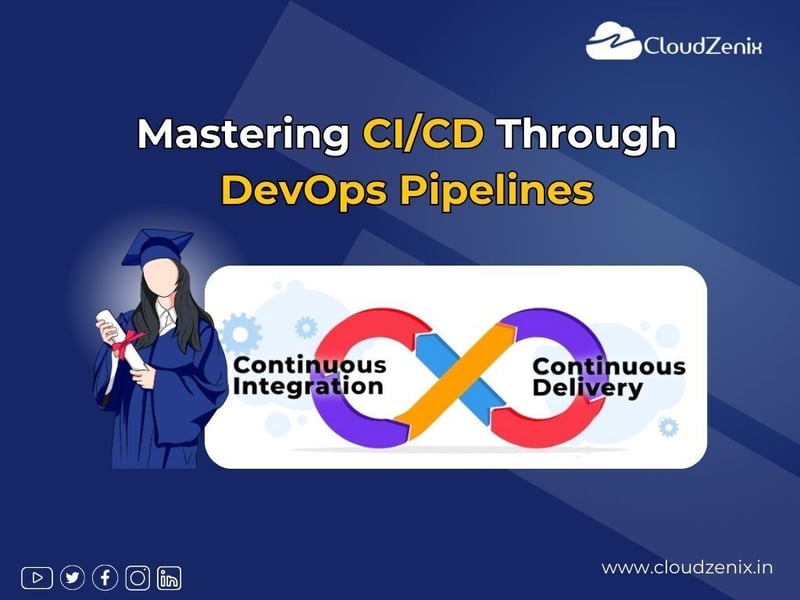Since continuous integration (CI) updates code automatically and is frequently incorporated into the main codebase, it is crucial to the software development process. When combined with DevOps pipelines, continuous integration (CI) becomes an essential part of the software delivery process, enabling teams to consistently and rapidly build high-quality software. In this blog article, we will delve into the world of CI and DevOps pipelines, looking at their benefits for modern software development processes as well as their interconnections and related technologies.
Introduction
In the software development process, continuous integration refers to the regular merging of team members' work, often occurring many times each day. Every integration is validated using automated build and test procedures, which help to find integration errors early on. By identifying problems early on, continuous integration (CI) seeks to enhance team member participation and expedite the development process.
Beyond continuous delivery, continuous deployment advances the procedure. Here, any modification that passes the pipeline's verification stages is made available for use in production. The only thing that will stop releasing the changes to production in this fully automated procedure is a failed verification step.
Understanding DevOps Pipelines
DevOps pipelines are sets of automated processes that facilitate the building, testing, and deployment of software applications. These pipelines orchestrate the flow of code changes from development through the testing and deployment stages. By automating these processes, DevOps pipelines help teams deliver software faster and more reliably.
The Role of Continuous Integration and Continuous Deployment in DevOps Pipelines
Integrating continuous integration is essential to DevOps pipelines. It guarantees that, as part of the pipeline, code modifications are automatically incorporated and tested. CI speeds up the development process, helps teams find errors early, and maintains a high standard of code quality.
Development teams can release software more quickly, consistently, and safely with the help of DevOps fundamentals like continuous integration and deployment. By using these methods, development teams and end users may achieve more effective development processes and better results.
Choosing the Right CI/CD Tools:
Continuous Integration Tools:
There are several CI tools available on the market, each offering unique features and integrations.
Popular CI tools include Jenkins, Travis CI, CircleCI, and GitLab CI/CD.
When selecting a CI tool for your DevOps pipeline, consider factors such as scalability, ease of use, integration capabilities, and community support.
Continuous Deployment Tools:
The right continuous deployment (CD) technology will depend on several aspects, including budget, scalability, integration capabilities, deployment complexity, and team familiarity.
Jenkins is perfect for teams with complicated needs since it allows for significant customization and plugin support.
Advanced tactics and multi-cloud deployments are areas in which Spinnaker excels. GitLab version control and CI/CD work together smoothly to ease setup.
AWS CodePipeline may be useful for teams that rely heavily on AWS services. Azure DevOps provides a comprehensive solution for Microsoft-centric environments.
CircleCI and Travis CI offer straightforward, scalable solutions for smaller teams. Which CD tool is ideal for your project will ultimately depend on how well you test and compare these products to your particular needs.
Building a DevOps Pipeline with CI Tools
To build an effective DevOps pipeline, you need to integrate your chosen CI tool with other components, such as source code repositories, testing frameworks, and deployment systems. This integration ensures that code changes are automatically built, tested, and deployed in a controlled and repeatable manner.
Some DevOps pipeline Tools are
Software is often built, tested, and deployed effectively through several phases in a DevOps pipeline. Every pipeline level has a different set of tools accessible. This is an illustration of a DevOps pipeline using standard tools:
Version Control: Git
CI/CD: Jenkins, GitLab CI, Travis CI
Code Quality: SonarQube, ESLint, Pylint
Artifact Repository: Nexus Repository, Artifactory
Automated Testing: Selenium, JUnit, and Pytest
Containerization: Docker, Kubernetes
Orchestration: Kubernetes, Docker Swarm
Continuous Deployment: Spinnaker, Jenkins
Monitoring and Logging: Prometheus, Grafana, and ELK Stack
Infrastructure as Code: Terraform, AWS CloudFormation, Ansible
How Continuous Integration Works in Practice
In a typical CI workflow, developers push code changes to a shared repository multiple times a day. The CI tool then detects these changes, triggers automated build and test processes, and reports the results back to the team. If any issues are found, developers can address them immediately, ensuring that the codebase remains stable at all times.
Continuous Integration vs Continuous Delivery
Continuous delivery goes one step further by automating the deployment of these changes to production, whereas continuous integration concentrates on regularly integrating and testing code changes. Code updates are always in a deployable condition and prepared for user release at any moment thanks to continuous delivery. CI and CD work together to provide the framework for contemporary software delivery methods.
Benefits of Implementing CI/CD Practices
Implementing CI/CD practices in your development process brings a plethora of benefits, including faster time-to-market, improved code quality, reduced manual errors, and increased team collaboration. By automating repetitive tasks and streamlining the delivery process, CI/CD enables teams to focus on innovation and delivering value to customers.
Best Practices for Successful CI/CD Implementation
To make the most of CI/CD practices, teams should adhere to best practices such as writing automated tests, maintaining a clean codebase, using version control effectively, and monitoring pipeline performance. By following these best practices, teams can ensure the reliability and efficiency of their CI/CD processes.
Conclusion
The development and delivery of software may be completely transformed by combining DevOps processes with continuous integration. Teams may achieve shorter delivery cycles, improved code quality, and increased productivity by automating their build, test, and deployment procedures. In today's fast-paced digital world, software development teams must use continuous integration and delivery (CI/CD) strategies to remain competitive.
In summary, enterprises that want to produce high-caliber software at scale must understand continuous integration with DevOps pipelines. It is not simply a fad. Teams may improve productivity and stimulate creativity in today's fast-paced software business by adopting best practices, choosing appropriate technologies, and comprehending the underlying concepts of continuous integration and delivery (CI/CD).







Top comments (0)